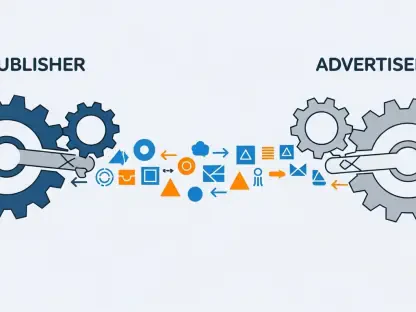In an era where European telecom giants face relentless pressure from declining revenues and fierce competition, Telefónica stands at a critical juncture with a new CEO at the helm. The Spanish operator has unveiled an ambitious five-year strategy aimed at reversing its fortunes through drastic cost cuts, market refocus, and technological innovation. This roundup gathers diverse opinions and analyses from industry experts, consultants, and market watchers to dissect the potential impact of this bold overhaul. The purpose is to provide a comprehensive view of whether this plan can reposition the company as a leader in a challenging landscape or if it risks alienating stakeholders with its aggressive moves.
Financial Restructuring: Bold Cuts or Risky Gambles?
Cost-Saving Targets Under Scrutiny
Industry analysts have expressed a mix of optimism and caution regarding Telefónica’s target to slash costs by €3 billion (approximately $3.4 billion) by 2030. Many consultants highlight the necessity of such measures, noting that operational inefficiencies have long plagued the company. A particular focus on reducing corporate operating expenses by 25% is seen as a feasible step toward streamlining the organization, with projected savings of €2.01 billion by the end of the decade.
However, skepticism lingers over the execution of these ambitious reductions. Some financial experts warn that deep cuts could compromise service quality or hinder necessary investments in infrastructure. The balance between cost efficiency and maintaining a competitive edge remains a point of contention, with certain observers questioning whether the projected savings are overly optimistic given past challenges in similar restructuring efforts across the sector.
Dividend Cuts Stir Investor Discontent
The decision to halve dividend payments has sparked significant debate among market commentators. On one hand, a segment of financial advisors argues that redirecting funds toward reinvestment is a prudent move for long-term stability, especially in a capital-intensive industry. They suggest that short-term pain for shareholders could pave the way for sustainable growth if the savings are channeled effectively.
On the other hand, other voices in the investment community view this as a misstep that undermines trust. A notable share price drop of 13% following the announcement reflects widespread concern among stakeholders. Critics contend that such a drastic reduction in returns might deter long-term investors, potentially offsetting gains from operational efficiencies if market confidence continues to waver.
Market Refocus: Strategic Retreat or Missed Opportunities?
Core Market Emphasis Gains Support
Telefónica’s pivot to concentrate on key markets—Brazil, Germany, Spain, and the UK—while exiting less profitable Latin American regions like Colombia and Chile has garnered mixed reactions. Several telecom strategists applaud the move as a pragmatic approach to resource allocation. By focusing on regions with stronger growth potential, the company could optimize its operational footprint and drive profitability, according to these perspectives.
Yet, not all feedback is positive. Some regional analysts argue that withdrawing from Latin America might sacrifice future upside in emerging markets. They point out that while current profitability is low, long-term demographic and technological trends could make these areas lucrative. The debate centers on whether this refocus truly strengthens the company or narrows its global presence at a critical time.
Consolidation Challenges in Key Regions
The potential for in-market consolidation within core markets is another hot topic among industry observers. A number of experts see this as a vital strategy to achieve scale and combat competitive pressures. They note that larger, consolidated entities often fare better in negotiations with regulators and suppliers, potentially giving Telefónica an edge in its prioritized regions.
However, regulatory hurdles pose a significant barrier, as highlighted by several policy consultants. The fragmented nature of European markets often complicates merger approvals, and there’s concern that anticipated synergies might not materialize as planned. This split in opinion underscores the uncertainty of whether consolidation can deliver the desired growth or if it will bog down the company in bureaucratic delays.
Technological Innovation: A Game-Changer or Overreach?
Massive Investment in Networks and IT
Telefónica’s commitment to invest €32 billion (about $37 billion) in networks and IT systems from 2026 to 2028 has drawn significant attention from tech analysts. Many in the field view this as a bold but necessary step to achieve advanced automation, particularly in key markets aiming for high-level network capabilities by the end of the investment period. Such advancements could position the company as a frontrunner in service delivery and efficiency.
Despite the enthusiasm, cautionary notes emerge from other tech commentators who question the affordability of such a hefty capital outlay. They argue that in a sector already burdened by high debt levels, this scale of investment might strain financial resources if revenue growth does not keep pace. The divergence in views highlights a critical risk-reward dynamic at play in this tech-driven strategy.
AI and Cybersecurity as Revenue Drivers
The push toward AI-driven hyper-personalization for consumer services and an expanded focus on cybersecurity in B2B offerings, targeting a 26% revenue share by 2028, also splits opinions. Innovation specialists commend the forward-thinking approach, suggesting that personalized services could enhance customer loyalty while cybersecurity addresses a growing corporate need. This dual focus is seen as aligning with broader industry trends.
Conversely, some market researchers express doubts about the timeline and scalability of these initiatives. They warn that competitors might already hold an edge in AI implementation, and the capital-intensive nature of tech development could stretch resources thin. This contrast in perspectives raises questions about whether these innovations will differentiate the company or expose it to operational risks.
Mergers and Autonomy: Visionary or Unrealistic?
M&A as a Strategic Upside
The vision for mergers and acquisitions to bolster scale, though not central to financial projections, has intrigued industry watchers. Several corporate strategy experts support the idea, arguing that strategic tie-ups in core markets could provide the necessary muscle to compete with global tech giants. They see this as an opportunity to enhance investment capacity and market reach.
Others, however, remain wary of the practicalities. Financial consultants point out that investor caution and a fragmented European regulatory environment could hinder such ambitions. The lack of a dedicated funding plan for M&A further fuels doubts about whether this aspect of the strategy is actionable or merely aspirational, creating a divide in expert assessments.
Europe’s Tech Autonomy in Focus
The advocacy for Europe’s strategic autonomy in technology, reducing reliance on US and Chinese innovation, resonates with many policy analysts. They argue that fostering domestic tech capabilities is essential for the region’s long-term competitiveness and security. This perspective aligns with broader continental goals to build independent tech ecosystems.
Yet, some pragmatic voices in the tech sector question the feasibility of this vision within the current global supply chain framework. They suggest that while the intent is commendable, actual policy shifts and industry collaboration might lag, limiting immediate impact. This split reflects a tension between ideological goals and operational realities facing European telecoms.
Key Takeaways from Diverse Perspectives
Reflecting on the varied insights, it becomes clear that Telefónica’s strategic overhaul sparks both hope and apprehension among experts. The aggressive cost-cutting measures and market refocus are often praised for their clarity and decisiveness, yet concerns about investor backlash and regional exits persist. Technological investments are hailed as visionary by some, while others see them as financially burdensome, and the push for mergers and autonomy divides opinions on practicality versus ambition. For readers and industry stakeholders, a deeper dive into specific market analyses or regulatory trends could provide further clarity on these complex issues. Exploring case studies of similar telecom turnarounds might also offer valuable lessons to contextualize this ongoing transformation.









